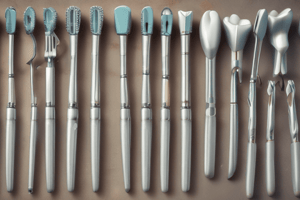Podcast
Questions and Answers
What is the primary function of a dental matrix during the condensation of restorative materials?
What is the primary function of a dental matrix during the condensation of restorative materials?
- To maintain the contact between teeth
- To protect the adjacent hard and soft tissues
- To provide permanent shape to the restoration
- To serve as a temporary wall during condensation (correct)
What is the minimum requirement for the thickness of a matrix band to preserve the contact between teeth?
What is the minimum requirement for the thickness of a matrix band to preserve the contact between teeth?
- 0.01 inch
- 0.005 inch
- 0.001 inch
- 0.002 inch (correct)
How far above the marginal ridge height should the matrix band extend?
How far above the marginal ridge height should the matrix band extend?
- 3 mm
- 2 mm (correct)
- 4 mm
- 1 mm
What is the purpose of a matrix retainer in a matrix system?
What is the purpose of a matrix retainer in a matrix system?
What is a key requirement for a matrix material to maintain its adaptation during condensation?
What is a key requirement for a matrix material to maintain its adaptation during condensation?
What is the primary advantage of using a circumferential matrix in amalgam restorations?
What is the primary advantage of using a circumferential matrix in amalgam restorations?
Which type of matrix is suitable for class II cavities?
Which type of matrix is suitable for class II cavities?
What is the primary advantage of the Tofflemire matrix?
What is the primary advantage of the Tofflemire matrix?
What is the main difference between Ivory Matrix No. 1 and Ivory Matrix No. 8?
What is the main difference between Ivory Matrix No. 1 and Ivory Matrix No. 8?
Which type of matrix is typically used in anterior restorations?
Which type of matrix is typically used in anterior restorations?
What is the primary characteristic of a retainerless matrix?
What is the primary characteristic of a retainerless matrix?
What is the purpose of the matrix band in a circumferential matrix?
What is the purpose of the matrix band in a circumferential matrix?
What is the recommended width of the band in relation to the marginal ridge?
What is the recommended width of the band in relation to the marginal ridge?
What is the primary advantage of the Automatrix?
What is the primary advantage of the Automatrix?
Which type of matrix is suitable for anterior restorations, such as class III, IV, and V?
Which type of matrix is suitable for anterior restorations, such as class III, IV, and V?
What is the characteristic of the Automatrix that distinguishes it from other matrices?
What is the characteristic of the Automatrix that distinguishes it from other matrices?
What is the primary use of the Cervical Matrix?
What is the primary use of the Cervical Matrix?
What is the characteristic of the Omni Matrix that makes it convenient for use?
What is the characteristic of the Omni Matrix that makes it convenient for use?
Flashcards are hidden until you start studying
Study Notes
Definition of Dental Matrices
- A dental matrix is a piece of metal or material that supports and gives form to the restoration during its packing and hardening.
- The term "matrix" refers to anything that contains and gives form to something else.
Functions of Matrices
- Matrices serve as temporary walls during condensation of plastic restorative materials.
- They give shape and contour to the restoration and maintain it until hardening.
- Matrices prevent marginal overhangs and keep gingival tissues away from the cavity margins.
- They protect adjacent hard and soft tissues.
Requirements of Matrix Materials
- Matrix materials should be easily adapted to teeth and maintain this adaptation during condensation.
- They should be easily introduced and removed.
- Matrix materials should be easily contoured and strong enough to resist the force of condensation.
- They should be thin enough to preserve the contact between teeth (0.002 inch).
- Matrix materials should have a smooth and highly polished surface to produce a smooth surface texture of restoration.
- They should be compatible with the restorative materials.
Parts of Matrix System
- Matrix Retainer (holder): holds a band in the desired position and shape.
- Matrix band: provides support and form to the restoration during its insertion and setting.
Classification of Matrices
- According to mode of application: with or without retainer.
- According to material of band: metallic (non-transparent) or non-metallic (transparent).
- According to type of cavity: class I, class II, class III, class IV, and class V.
- According to extension of matrix: circumferential or sectional.
- According to dentition: anterior or posterior matrix.
Types of Matrices
- Ivory Matrix No. 1: provides only one proximal wall, used in occluso-mesial or distal cavities for amalgam restorations.
- Ivory Matrix No. 8: can encircle the whole crown of the tooth, used in all compound and complex cavities for amalgam restorations.
- The Tofflemire or universal matrix: considered the best in its stability and anatomic adaptation, suitable for all cases.
- The Automatrix: consists of a ready-made band that encircles the tooth, suitable for compound and complex cavities, especially extensive cavity preparations.
- The Omni Matrix: consists of a ready-made band and retainer attached to each other, suitable for compound and complex cavities.
- Unica anterior matrix: simple and ideal matrix for anterior restorations, makes it possible to restore interproximal and cervical margins at once, reducing chair time significantly.
- Cervical matrices: used in class V restorations.
Studying That Suits You
Use AI to generate personalized quizzes and flashcards to suit your learning preferences.


